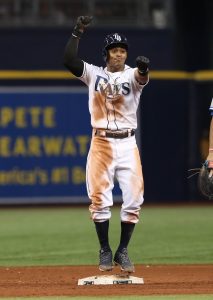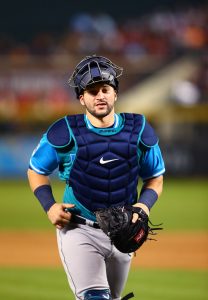As the season draws closer, we’ll be examining several prominent players around the majors who are hoping for bounce-back years. Let’s start with a group of well-known American League West position players whose numbers dipped dramatically in 2019…
Justin Upton, LF, Angels: The 32-year-old Upton has been terrific for the majority of his career (otherwise, the Angels wouldn’t have given him a five-year, $106MM guarantee after 2017), but last season was a nightmare. A foot injury kept Upton out until June, and his season ended prematurely in September on account of a right knee issue. When Upton was healthy enough to take the field, he batted a disappointing .215/.309/.416 with 12 home runs and a career-worst 30.5 percent strikeout rate (5 percent worse than his lifetime mark). Compared to 2018, his fly ball percentage and launch angle went way up, but his average exit velocity dropped almost 4 mph, and his hard-hit rate plummeted. The banged-up Upton was even worse in left field, where he accounted for minus-13 Defensive Runs Saved and a minus-5.2 Ultimate Zone Rating. Upton recently told Jeff Fletcher of the Orange County Register that he’s healthy and aiming for a rebound. The Angels will likely need one from him if they’re going to break a five-year playoff drought; if they get one, Upton should form a lethal offensive quartet with Mike Trout, Anthony Rendon and Shohei Ohtani.
Andrelton Simmons, SS, Angels: Like his teammate Upton, Simmons missed a significant number of games last year because of injury issues. Ankle troubles limited Simmons to 103 games, his fewest since 2012, and his effectiveness at the plate waned compared to the prior couple years. While Simmons has never been an offensive force, the defensive maven’s slightly above-average work with the bat from 2017-18 helped him combine for 10.4 fWAR in that span. Simmons only put up a .264/.309/.364 line in 424 PA last year, though he did continue to avoid strikeouts (8.7 percent), and his wizardry in the field helped him to a respectable 1.7 fWAR. However, he still finished near the bottom of the majors in several key offensive Statcast categories. For instance, Simmons’ xwOBA (.265) ranked in the bottom 2 percent of the league and fell 59 points from 2018. The ankle may have been holding Simmons back, but regardless, a return to form in 2020 would aid the Angels and the pending free agent’s bank account.
Khris Davis, DH, Athletics: Yet another injury case from 2019, Davis’ normally elite power was sapped during a season in which he fought hip, oblique and hand problems. After three straight 40-home run seasons (and four in a row in which he hit .247), he finished with a .220/.293/.387 line and 23 HRs over 533 PA. His ISO sunk like a stone, going from .302 in 2018 to .166 last year, and his hard contact went way down in the process. The 32-year-old has already been slowed by a calf injury early in camp, but indications are that it’s minor. Oakland will need that to be the case, especially considering the commitment the low-budget club made to Davis before last season. It still owes him $16.75MM on a two-year, $33.5MM contract that hasn’t worked out for the team so far.
Stephen Piscotty, RF, Athletics: The missed time theme continues. Piscotty’s 2019 ailments ranged from frightening (a melanoma on his right ear) to more conventional (knee and ankle injuries). The 29-year-old made just 93 appearances as a result, and he didn’t produce like the big-hitting, 3.0-fWAR player he was in 2018 when he did play. Piscotty hit .249/.309/.412 with 13 homers and 0.6 fWAR in 393 PA, though his hard-hit percentage and average exit velocity both increased. There may be hope for return to his career-best output, then, but Piscotty will first have to get over yet another health issue. He’s dealing with an oblique/rib cage injury that could jeopardize his status for Opening Day.
Mitch Haniger, RF, Mariners: Haniger was quietly great in 2018, but his playing time and his numbers sagged last season. He sat out 99 games after suffering a ruptured testicle at the beginning of June, didn’t play again after that and still hasn’t returned to health. Haniger just underwent his second surgery in the past few weeks – a microdiscectomy on his back – leaving it up in the air when he’ll debut in 2020. The 29-year-old is the Mariners’ best player, though, and if they can get a healthy version back sometime in 2020, he’s as logical a bounce-back candidate as anyone.
Mallex Smith, OF, Mariners: Smith looked like a quality pickup for the Mariners when they acquired him from the Rays after the 2018 campaign. At that point, the speedster was coming off a 3.5-fWAR, 40-steal showing in Tampa Bay. Smith amassed even more stolen bases in is first year in Seattle (46), but the rest of his stats tanked. The 26-year-old hit a weak .227/.300/.335 in 566 trips to the plate, while his defensive output was similarly poor (minus-12 DRS, minus-9.5 UZR). The combination of subpar offense and defense led to a replacement-level fWAR for Smith, who also fell victim to a massive decline in batting average on balls in play. He logged an inflated .366 BABIP in ’18 and a .302 mark in that category last season, which partially explains the drastic difference in year-to-year production.
Rougned Odor, 2B, Rangers: If you’re a Rangers fan (or even part of the organization), you may be tired of Odor’s inconsistency. He has been a 2.0-plus-fWAR player three times in his career, most recently in 2018, but a replacement-level or worse performer twice. That includes last season – even though Odor walloped 30 homers, he was only able to slash .205/.283/.439 in 581 tries. Along the way, the left-handed Odor posted his worst strikeout percentage (30.6) and was eaten alive by righty pitchers, who held him to a dismal .190/.260/.417 line. If there’s a silver lining, it’s that Odor was much better in the second half of the season, ending the year with a flourish after general manager Jon Daniels expressed frustration with his production in late August. The Rangers still owe Odor $36MM through 2022, making it all the more important for the club to receive at least passable production from him.

